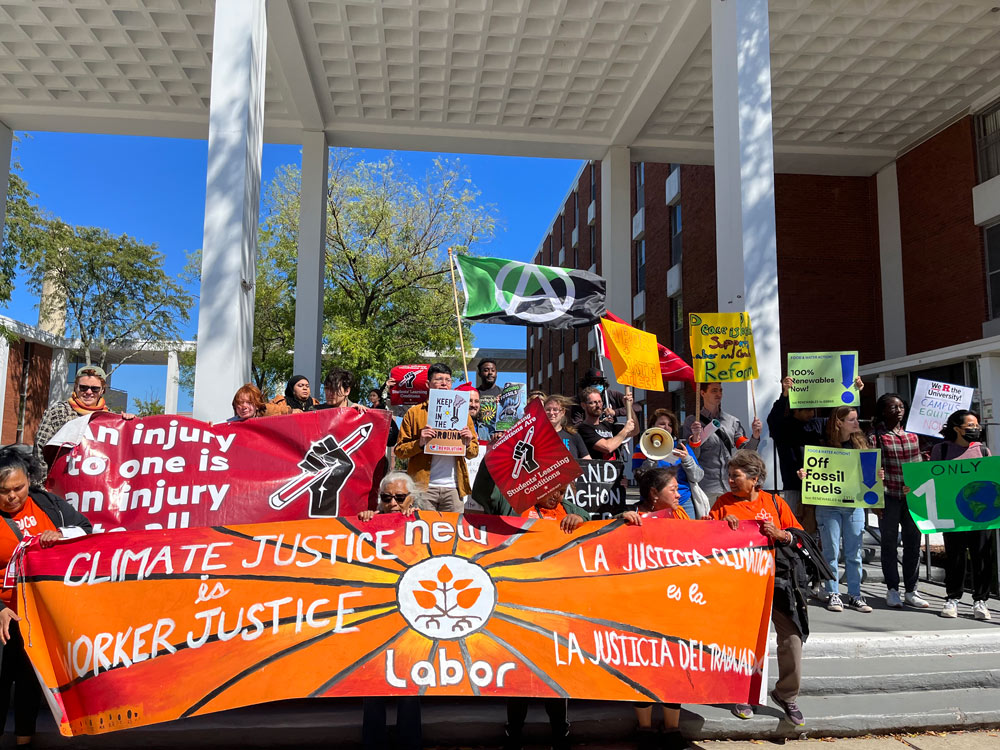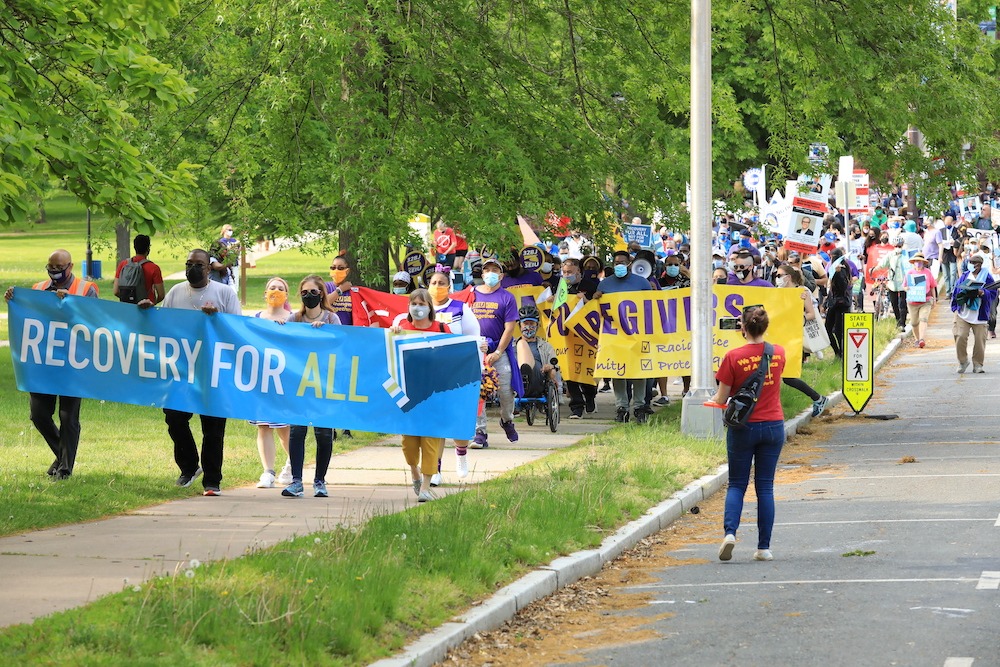
This article is the eighth and final installment in our series co-produced by Bargaining for the Common Good and NPQ, titled Building a Movement for the Common Good. In this series, we learn how and why Bargaining for the Common Good (BCG) is the right strategy for our times of social crisis, featuring extreme wealth inequality and declining democracy as well as a renewed attention to labor organizing and mass uprisings for racial justice. The authors explain that in order to reverse extreme inequality in the housing market, we must organize to take on corporate landlords.
The COVID-19 pandemic made the wealthiest people in the US much richer. While a million Americans died, and we endured the worst health crisis in a generation, the powerful consolidated their financial position. By May 2022, US billionaires’ wealth had grown by $1.7 trillion since the coronavirus crisis began.
A key component of concentrated wealth is real estate, ie, the ownership and management of land and buildings. Controlling real estate has historically been a central piece of gaining and maintaining power. This is no less true today. The richest people in the world use land and buildings as vehicles for hiding their assets and as investments to increase their capital. In doing so, they have weaponized real estate not just to grow their wealth, but to control our communities.
A particularly virulent version of wealth concentration is the transformation of housing in the US. Our housing system is dominated by companies focused on generating profits that primarily benefit the mega-rich. This takeover has fundamentally altered the experience of securing housing in this country. This is especially true for middle- and low-income families and communities of color, who make up a disproportionate share of renters. Rent has become exponentially more expensive while essential maintenance of rental properties has declined, especially in historically affordable urban and suburban areas that are relatively close to jobs.
If we want to make the systemic changes necessary to build a just and equitable country, we must understand the roots of these changes—and develop strategies to take on those who enable them.
Targeting Our Neighborhoods
As the pandemic rages on, housing remains key to understanding the drivers of wealth inequality. In a time of economic downturn for most, corporate landlords—large-scale, investor-driven companies that own hundreds, even thousands, of housing units—have posted record profits. The top 10 publicly traded apartment companies saw their profits rise 57 percent in 2021 to nearly five billion dollars. Meanwhile, in May 2022, the median monthly asking rent in the US surpassed $2,000 for the first time in history, rising 15 percent year after year to a record high of $2,002. And while rents are increasing astronomically, mortgage payments are also going up, surpassing rents in many areas. Corporate landlords are exacerbating the problem, often both raising rents and buying up affordable homes in urban areas.
Unsurprisingly, these landlords and their investors have consistently opposed rent controls, protections from arbitrary and discriminatory eviction, and other efforts to ensure we have access to safe, affordable places to live. During the pandemic, these companies and the associations they support even fought the eviction moratorium.
One recent and promising approach to combat this assault is Bargaining for the Common Good (BCG), which brings together labor unions and community groups like tenants’ rights organizations to fight corporate power. In July 2019, over 200 leaders from housing justice and community groups, worker centers, and local and national labor unions gathered in Chicago for BCG’s Housing Justice Convening to share information on corporate landlords, increase their collective understanding of the tactics these landlords use, and discuss the necessity of strong labor and community partnerships to confront the country’s housing crisis. At the convening, members and staff from the Chicago Teachers’ Union (CTU), which represents educators across the city, led a workshop around their contract negotiations and the importance of housing for teachers, students, and the community.
A few months later, CTU, along with SEIU 73, another local union representing school district employees, went on strike with housing as a central demand. They emphasized that over 18,000 students were homeless and highlighted the billions in tax subsidies that real estate developments had received. Thousands of teachers, students, parents, and community members took to the streets demanding affordable homes as a part of the Chicago they deserve.
They didn’t just have allies in Chicago. Community Voices Heard (CVH), a member-led, multi-racial community organization that organizes low-income and working-class communities in New York State, was at the July convening. CVH’s board immediately issued a statement supporting the Chicago campaign. Union and community members and their organizations around the country showed their support in a myriad of ways. This powerful coalition won a commitment to hire additional staff to support homeless students and their families. To change our future, we must learn from our recent past.
Breaking Down the History of Corporate Landlords
In order to build out BCG strategies, we need to understand how we got here. How and why did wealthy investors target housing? In the 1960s, the US created the Real Estate Investment Trust (REIT), which enabled individuals to invest in real estate without actually having to own it. A company that qualifies as an REIT is allowed to pay out money to (often very wealthy) shareholders and owe little to no corporate tax. As manufacturing profits declined and financial institutions became All of these developments mean that unregulated financial activity is highly prevalent in the housing market—activity that historically causes economic crises.
The First Step: Consolidating Apartments
In the US, most of our homes fall into three categories, or subsectors, that make up what economists, academics, and others refer to as the “residential sector”—single-family, multi-family, or manufactured housing.
Sign up for our free newsletters
Subscribe to NPQ's newsletters to have our top stories delivered directly to your inbox.
By signing up, you agree to our privacy policy and terms of use, and to receive messages from NPQ and our partners.
The wealthy came for apartments first. Rich men like Sam Zell, a well-known real estate investor with a net worth of $5.8 billion, used REITs and LLCs to amass large numbers of apartment buildings in companies like Equity Residential. Employing a similar approach, investors and their companies have bought up millions of housing units over the last several decades, concentrating ownership of large apartment buildings. The corporate landlord was born. In 2018, researchers found that nationwide, 63 percent of rental properties with 150 or more units were owned by limited liability corporations (LLC) or partnerships.
These companies, including names like Mid-America Apartment Communities (MAA), Related Companies, and Starwood Capital Group, are particularly prominent in large cities. They are owned by some of the richest people in the world, like Warren Buffett of Berkshire Hathaway and Barry Sternlicht of Starwood Capital. Altogether, the top 50 apartment owners in the US own over 2.3 million housing units.
The Great Recession and the Growth of Single-Family Rentals
In the early 2000s, single family homes, the quintessential symbol of a successful American family, were still relatively untouched by this approach. Then came the Great Recession. From 2007 to 2011, almost six million homes were foreclosed or lost to short sale. Seeing an opportunity, wealthy investors and financial firms created new ways to finance purchasing homes in bulk. For example, Don Mullen, a former Goldman Sachs executive who helped design the financial instruments that allowed the firm to profit from the 2008 housing market collapse, took their windfall and created a company called Pretium Partners (and subsidiary Progress Residential) to buy up foreclosed homes and rent them out. While they didn’t create this model, investors like Mullen and their companies scaled up the sector, dramatically expanding the amount of funding available. In addition to Progress Residential, the corporate SFR subsector includes FirstKey Homes, Invitation Homes, American Homes 4 Rent, and Amherst Residential.
Over the last decade, investors consolidated companies, bought tens of thousands of single-family homes, and marketed the SFR rental market to whoever would listen, promising quick, high returns. The approach proved so lucrative that today, dozens of corporate landlords are active in the SFR space, and thousands of firms are invested. These companies are known for poor maintenance practices, constant rent increases, litanies of fees, and high tenant eviction rates.
While SFR companies have not concentrated single-family home ownership to the degree that corporate landlords have concentrated ownership of apartments, they have had huge impacts on specific regions of the country. Research in the Atlanta area, for example, shows that corporate landlords own up to 35 percent of single-family homes in some neighborhoods. An analysis released in October 2021 by the Shelby County Assessor, where Memphis, TN, is located, found that corporate landlords purchased over 7,000 homes in the county in just the past two years. For perspective, just over 2,000 permits were issued to build new homes in the same county in all of 2021. In February 2022, a Washington Post report looked at where investors purchased homes, focusing on 40 cities. They cited varying levels of investor activity, “with southern cities and Black neighborhoods disproportionately affected.” They found that investors bought 25 percent of homes purchased in all of Charlotte, NC, with one zip code reaching 53 percent.
These firms are looking to further tighten their grip on the single-family home rental industry by partnering with homebuilders, an already consolidated space, in a practice called “build to rent.” With this strategy, corporate landlords and homebuilders form single-family home development companies (billion-dollar operations in their own right) and build entire communities designed for corporate landlords to rent. For example, in July 2021, PulteGroup, one of the largest homebuilders in the US, and Invitation Homes, the largest SFR company in the country, announced a strategic partnership to build around 7,500 homes in five years, with projects in Florida, Georgia, Southern California, North Carolina, and Texas. These homes will never be available to families—instead, they have already been sold to Invitation Homes, a home leasing company, as single-family rental properties.
The Last Frontier: Trailer Parks
It doesn’t stop there. Exploitative investment in housing extends to the last subsector of the US housing market: manufactured or mobile homes, also known as trailer parks. In the mid-2010s, investors realized they could turn a quick profit by purchasing the companies that owned the land under mobile homes and immediately raising the rent charged for the “lot,” or the space where people park their home. Investment companies, including Blackstone, a firm with over $150 billion in assets, have already bought up tens of thousands of home lots. Sam Zell has also jumped into manufactured housing, forming Equity LifeStyle Properties, which boasts 17 percent returns. Investors promoted manufactured housing as a prime opportunity, and many companies jumped in, using methods similar to those used by corporate landlords of SFR and apartments—raising rents, providing poor maintenance, charging high fees, and quickly evicting.
Building a New System
We need change, but this fight isn’t just about housing—it’s about power. By buying up single-family homes and trailer parks in key neighborhoods and owning a majority of apartment buildings, billionaires set the price for the largest expense in a family budget, often determining where we can live. And the same folks that own, control, and/or invest in these companies often own or manage the companies where we work. They may also invest in or own the only utility or water company in our area, the mall down the street, and the grocery store we shop at. Given this reality, it is both strategic and vital to develop strategies to take on corporate landlords and their investors.
BCG strategies are helping us understand how to do this work. For example, we’re seeing the possibilities of using BCG to take on corporate landlords in Minnesota. Members of Tending the Soil (TTS), an alignment of Minneapolis-based labor and community organizations doing common good work, include Inquilinxs Unidxs/Renters United for Justice (IX), a housing justice organization that is organizing tenants of SFR corporate landlord Pretium Partners to engage the company and its leadership directly. Pretium, the second largest SFR operation in the country, with $38.5 billion in assets under management, owns a management company, HavenBrook Homes, which has over 200 homes in North Minneapolis, where many Black families live, and owns 70,000 homes across the US.
The company’s Minneapolis tenants are working with IX to address persistent and urgent maintenance issues, including holes in the walls, pest infestations, electrical, heat and plumbing problems, ongoing rent increases, and endless fees. Tenants, IX, and their allies have sent the company letters, spoken with Pretium’s potential and current investors, met with local elected officials and Congressional members, and had multiple meetings with company staff. Tenants with maintenance issues have placed their rent “in escrow,” where the courts accept rent payments rather than landlords and pay it back to tenants if repairs are not made. In June 2022, as part of TTS’s Week of Action, IX led a group of tenants and supporters to the company’s local offices, highlighting their status as a corporate landlord.
In California, the global private equity firm, Blackstone, bought 66 apartment buildings throughout San Diego County, totaling nearly 6,000 housing units, in the fall of 2021. The majority of residents are low-income people of color. Like Pretium tenants in Minneapolis, they suffer from poor conditions and lack of repairs as rents escalate. Organizing with the community group, Alliance of Californians for Community Empowerment (ACCE), these tenants learned that public employee pension funds across California and the US invest worker retirement funds in Blackstone. The tenants partnered with Service Employees International Union (SEIU) 221, a local union representing over 10,000 San Diego County workers, to demand that the San Diego County Employees Retirement Association (SDCERA) reevaluate its investment in the company. It also pushed Blackstone national management to meet with the ACCE Blackstone Tenants Union, resulting in initial wins around repairs and a grievance procedure.
As we work to fight corporate power, housing is a key piece of the puzzle. If we are to dismantle the system wealthy investors and corporate landlords have built, local organizations and tenants need training and resources to figure out who owns their homes and develop the capacity to run strategic common good campaigns. They need to connect with each other across cities and states and coordinate around collective demands. The BCG approach is a perfect fit for this fight; it provides a framework and supports movement organizations to unite around a shared understanding of who holds power and learn the skills needed to win.











